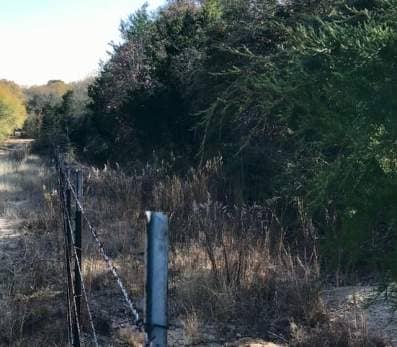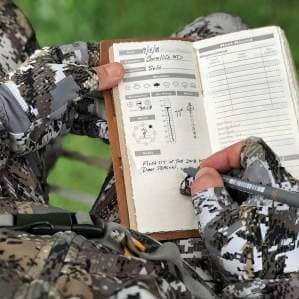I sat down, flipped open my laptop, and let out a huge sigh. It was time to take a closer look at my current hunting property. With a handful of mature bucks already caught on camera, I had yet to connect on one.
Among other things, I had no real idea what direction they came from.
These bucks had largely dispersed as the rut approached, making their habits even more confusing. I pulled up an aerial map of the property displaying various land features and sections of cover. Often ignored, it also highlighted my property boundaries – and particularly big zones of cover just on the other side of my north fence line. My mental calculations told me this was probably no more than 1,500 yards from my two bow hunting setups.
At a minimum, these were great staging areas for deer that frequented my hunting property. They were also a part of the core area for these deer – maybe even their bedding areas.
I mentally scolded myself for not placing trail cameras in these areas near the property boundary over the summer. It was now too late to venture into this sanctuary. It was also too late to request hunting permission on the bordering property.

Find or create a concealed location where you can see a good distance up and/or down a fence crossing.
Property lines are a huge component of hunting free-range deer. Shared deer populations can keep you guessing especially for those dividing small to medium parcels. In these areas, it’s common for a buck’s core area to span two (or more) properties. We all know that hunting too close to fence lines is a huge faux pas in the hunting world, as it should be. However, with a little etiquette and common sense, scouting these edges is a great strategy, one that’s often overlooked.
While you can use trail cameras to scout fence lines, they only capture a small area. You’ll need quite a fleet of them for ample coverage.
There is a better way. It’s called digiscoping.
By magnifying and capturing images, this nifty strategy is tailor made for property boundaries too. Why? Because it allows for capitalizing on long views near and along fence lines.
A quick refresher. Digiscoping is the process of pairing optics and smartphone devices via an adaptor kit. Phone Skope’s custom adapter offerings accommodate virtually every brand and model of devices and optics out there and you can seamlessly build your kit at PhoneSkope.com.
Digiscoping is a great tool for capturing and documenting how deer use your property as it relates to neighboring tracts. Rather than invading fence lines with a barrage of trail cameras, digiscoping these areas can be very effective in inventorying bucks and deer movement. – and it’s less invasive if you choose wise times and locations for setting up. Further, it allows you to survey much larger distances of these golden crossings.
This is yet another way a Phone Skope adapter kit can kick your whitetail scouting up a notch.
Why to Digiscope Fence Lines for Deer
Whether in open farm country or spans of woodlots, fence lines serve as great funnels between cover. In terms of feeding and travel, whitetails are edge creatures – and fence lines often provide edge cover, even if in small strips. At a minimum, these crossings are made up of sapling trees, brambles, and grasses. Spans of barbed wire and field fence are much more than boundaries, they’re an integral part of deer habitat. As such, it should come as no surprise that they are often loaded with scrapes and rubs.
These golden borderlines provide a great opportunity to survey deer and deer movement via photos and video. Along with your optics and smartphone, the Phone Skope adaptor will visually close the distance on them. In-person scouting magnified.
When to Digiscope Fence Crossings for Deer
Just like with hunting, scouting fence lines is ideal during late summer and early season. Generally speaking, whitetail summer travel patterns range from around July through as late as mid-October before the pre-rut kicks in. Pick peak travel times such as the early morning or late evening.
How to Digiscope Fence Lines for Deer
The actual act of digiscoping fence lines is not difficult. First, set up (on your side of the fence of course) in the heavy brush with a good line of sight in at least one direction along the fence (or both if possible) The biggest test is finding a good spot that provides concealment and maximum sight-lines. Look for naturally brushy areas at least 10-50 yards from the boundary.
Use the natural cover to your advantage. You can either hunt from an elevated position in a tree stand or homemade perch or set up on the ground. The latter will entail cutting some area limbs to create a ground blind. In either case, make sure you can see as far as possible in at least one direction up or down the border.
If scouting from the ground, consider using a tripod along with your digiscoping setup. This will help you to stabilize for better images. To keep your scouting low-impact, ensure that the wind is in your favor. The best scenario is to avoid being upwind of at least one direction along the boundary. To that end, spraying down with a good scent eliminator is a great idea as well.
After Each Session
Finally, document your findings in some way for future hunts and seasons. Further, do so after each and every fence line digiscoping session. Document as many variables as possible, including time, travel direction, weather conditions. Don’t leave your findings to memory. If you collect and analyze the data over longer periods, more sound future hunting decisions can be made. It can also help you add features such as food plots on your property to leverage your findings.
Conclusion
Grab your optics, smartphone, and Phone Skope adaptor kit and hit the edges of your hunting grounds. Plan a day when the conditions are right and learn away. You’ll be glad you have pictorial evidence of common whitetail travel corridors across properties. Phone Skope’s magnified images and video will not only tell you a lot about how whitetail bucks use your property, they can put you in position for a quality shot.



